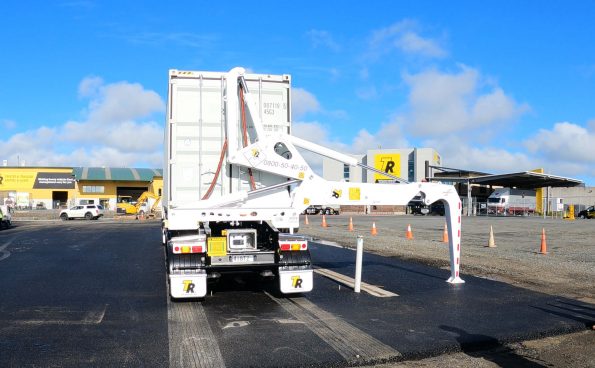A typical sideloader (or sidelifter) is a skeletal trailer with two or three cranes that are used to lift containers or platforms on and off. This self-loading ability makes them a versatile vehicle, particularly for delivering containers the final mile.
However, sideloaders are notoriously dangerous to operate and require specific training for the operator. You can view sideloader training here. There are multiple ways that accidents can occur.
Off-side rollover
When lifting, stabiliser legs extend either side of the container to provide support and prevent the sideloader from rolling over. The off-side of the sideloader often doesn’t have stabilising legs. If the container swings, or the operator moves the container too far to the off-side, the trailer can tip over. To avoid this, always use off-side stabiliser legs if they are fitted, and keep the container height as low as possible when manoeuvring it onto the twist locks. Be aware of strong winds that cause the container to sway, and correct any swaying movement before trying to place the container.

Off-side rollover can also occur if the trailer is parked on a slope that slopes towards the off-side. Sideloaders should not be parked on slopes of any more than a degree or so – check the manufacturer’s recommendations.
Operator or pedestrian is crushed
Every year, several people are killed or injured when they are trapped and crushed either by the sideloader mechanism, or by a swinging container. Always respect the exclusion zone as noted on the sideloader warning decals. Know exactly where the emergency stop (e-stop) buttons are. Always use a remote rather than operate the sideloader from the crane controls.
If you are loading to someone else’s truck, always keep the driver in your sight; never let them wander around the exclusion zone. If anyone has to enter the exclusion zone, activate the e-stop until they have left.
No one should ever walk underneath a suspended container.
Chain breakage
If a chain holding a container breaks, one end will be flung out away from the container. This can impact people who are standing too close. Keeping out of the exclusion zone will help avoid this.
Chains must be inspected as part of the pre-start inspection checklist and replaced if they are corroded, stretched or otherwise damaged. Stretched chains are easy to spot because one chain of the pair will be longer than the other.
If the chains break, this can cause the container to drop and roll, depending on how it was being lifted and whether it impacts the side of the trailer.
Vehicle rollover while driving
Because it’s impossible to see what is inside a container, there’s a risk that the weight distribution may be unfavourable for the driver when driving, and could cause a rollover risk. A driver that’s concerned about load balance should first use the sideloader’s in-built scales to ascertain which end of the container is heaviest.
If the sideloader doesn’t have scales, a visit to a weighbridge will give the driver peace of mind.
Twistlocks
When delivering a container to a port where a crane or straddle carrier will remove the container directly from the vehicle, ensure all twistlocks are unlocked, otherwise the vehicle will be picked up with the container.
When loaded, ensure that all twistlocks are engaged so that the container doesn’t roll off the vehicle when cornering.
You can hire a sideloader from us here.
